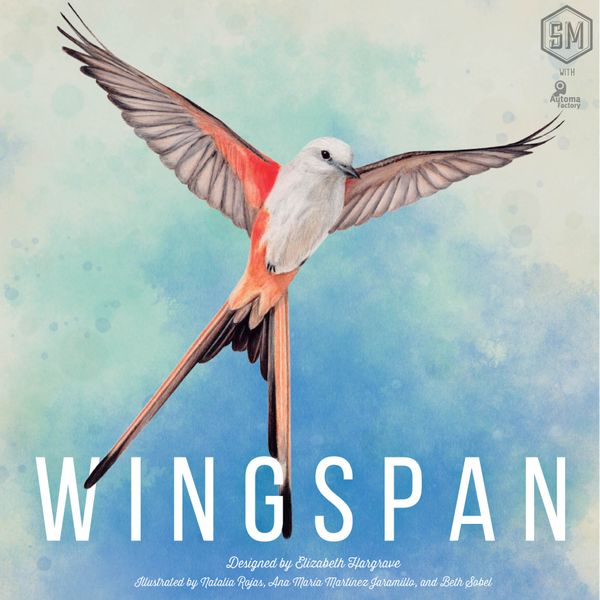Favourites from my collection
#4 Wingspan
Since its launch in 2019, Wingspan has been a huge hit, one which hasn’t only been limited to board gamers. The theme of being bird watchers/ornithologists/researchers is an appealing one, if only because it’s different from the perceived norm of board games. Trading in the Mediterranean, war or farming aren’t exactly the most inviting themes to someone who doesn’t play many, if any, games, but fortunately, designers and publishers have been doing more in recent years to attract a larger audience. Elizabeth Hargrave (the designer) and Stonemaier Games (the publisher) came together to put out something which has achieved this. Along with the enticing theme, the game is a brilliant one too.
Sometimes though, a theme can seem pasted on to a very mechanical game, and will be met by disappointment. Wingspan, for me, is not one of these games. Elizabeth clearly put a huge amount of work into bringing out the theme; every card portrays a different bird (along with a fact about each bird), the birds’ habitats, food requirements and sizes researched, and special powers tailored to the behaviours of said birds. This is perfectly accompanied by the levels of production of the game. Stonemaier Games are well known for the effort they put into making their games as aesthetically pleasing as they are good to play, and while some may argue that they aren’t always so successful, I think Wingspan comes through. They give you resin egg miniatures, a cardboard birdhouse-shaped dice tower and beautiful art throughout, amongst other things. There are people within the hobby who will say that this game is ‘overproduced’, generally meaning that a company has added unnecessarily upgraded components to put the price of the game up. Personally, I think that these extra touches not only make it a game that is more likely to hit the table but also enhances the game experience, and I am more than happy to pay a little extra.
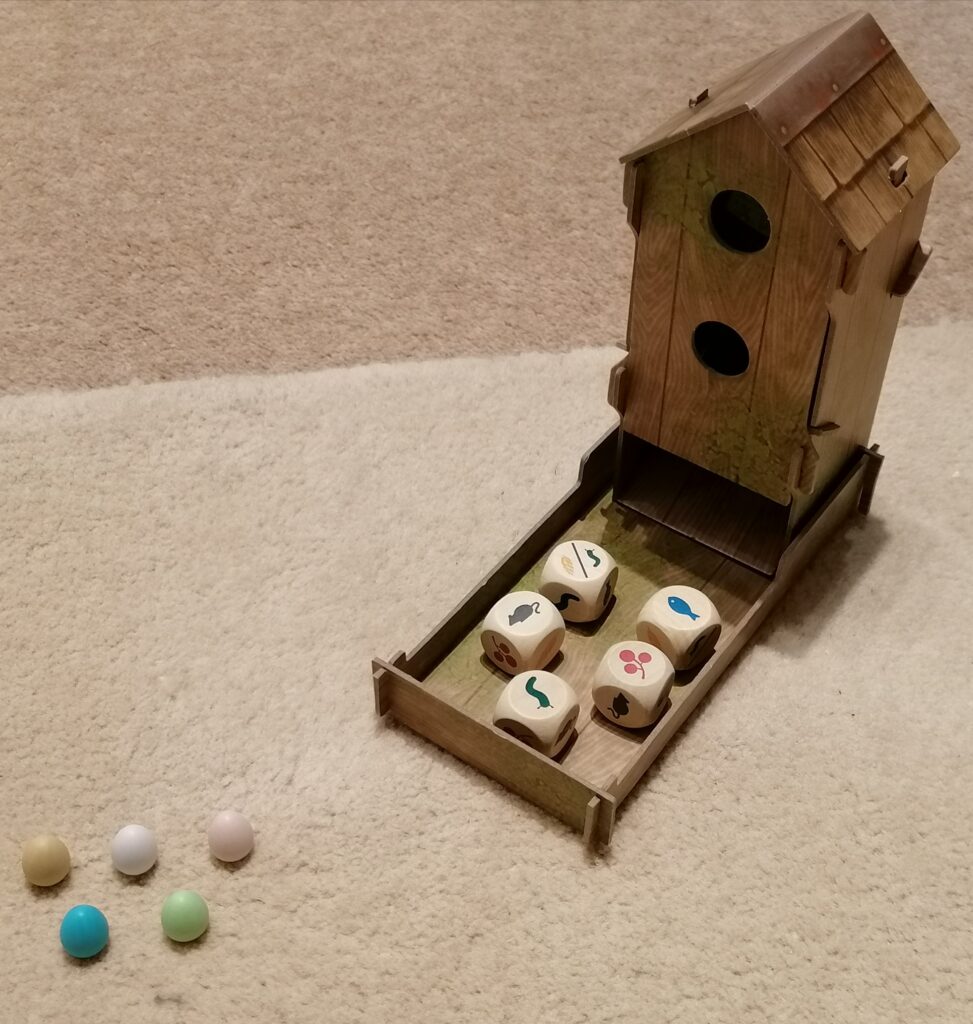
Wingspan is an engine-building (not the first and not the last in my favourites) card-based game where you will play birds into three different habitats; forest, grasslands and wetlands, on your player board, with the overall goal being to amass the most points. At the start of the game, you’re dealt 5 bird cards, two objective cards, and given one of each type of food (fruit, seed, rodents, fish and invertebrate), which you use to play the bird cards on to your board. You are instantly met with two main decisions. Which birds do you want to keep in your hand and which objective you want to start the game with? For every bird you want to keep, you’ll need to pay one food type of your choice. It’s probably a good idea not to discard food that you need to play the birds you’re going to keep, but you could choose to keep food that you’ll need to play cards that aren’t yet in your hand. The objective cards are interesting, as not only do they give you something else to aim for, but they also have a percentage at the bottom, telling you how many birds in the deck will help towards fulfilling the objective. Choosing a card with a lower percentage will most likely be worth more points, but is more difficult to achieve.
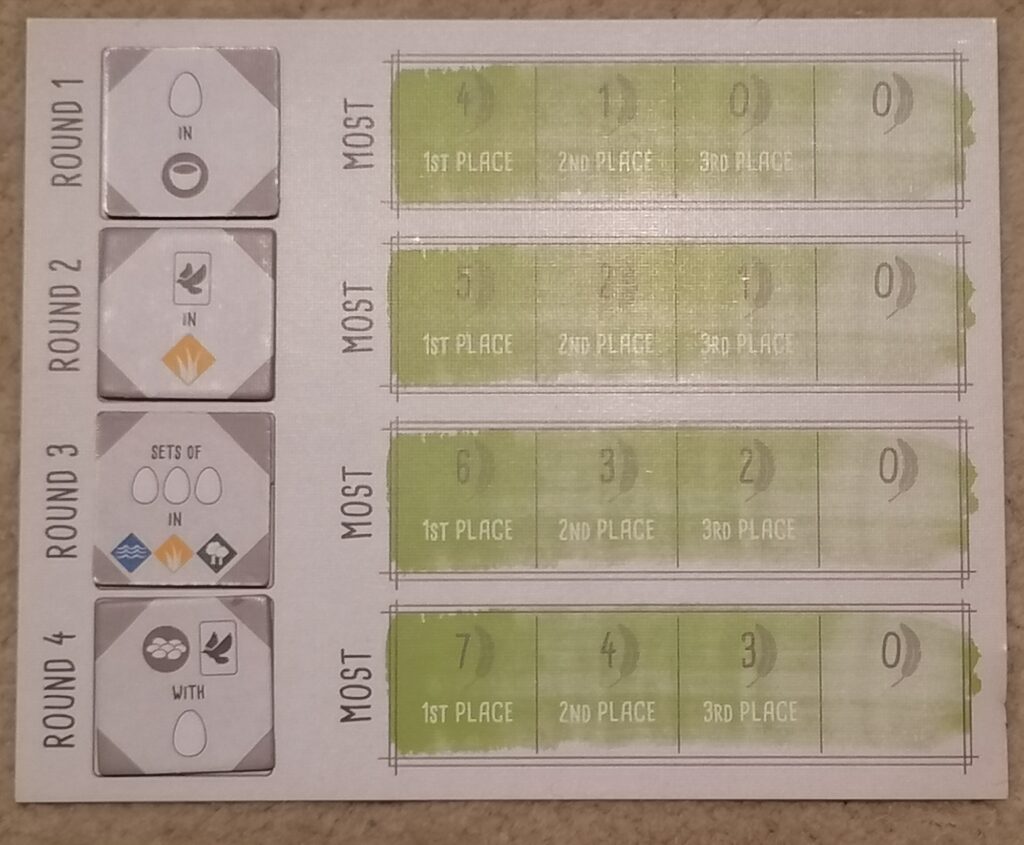
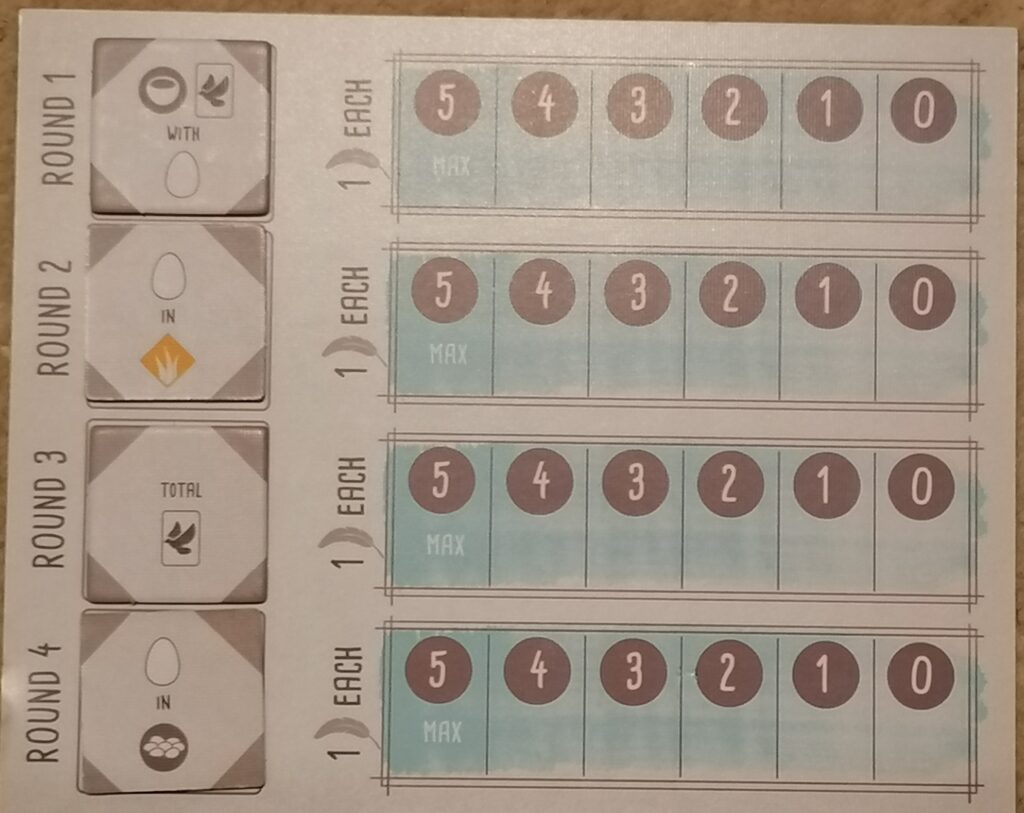
Another way to gain points in this game is the public objectives, of which there are four, one for each round. Your group can either choose to play for a majority or to play in a more friendly manner, with everyone scoring points based on how many cards you have played which meet the requirements. I’ve always played with the majorities, but this other way to score is another way that this game has been made to appeal to as many types of players as possible. The thing that makes these objectives even more interesting is that you will place one of your action cubes on the board to score them. At the beginning of the game, each player has eight action cubes, but as the rounds go on, you lose more action cubes to this scoring area.
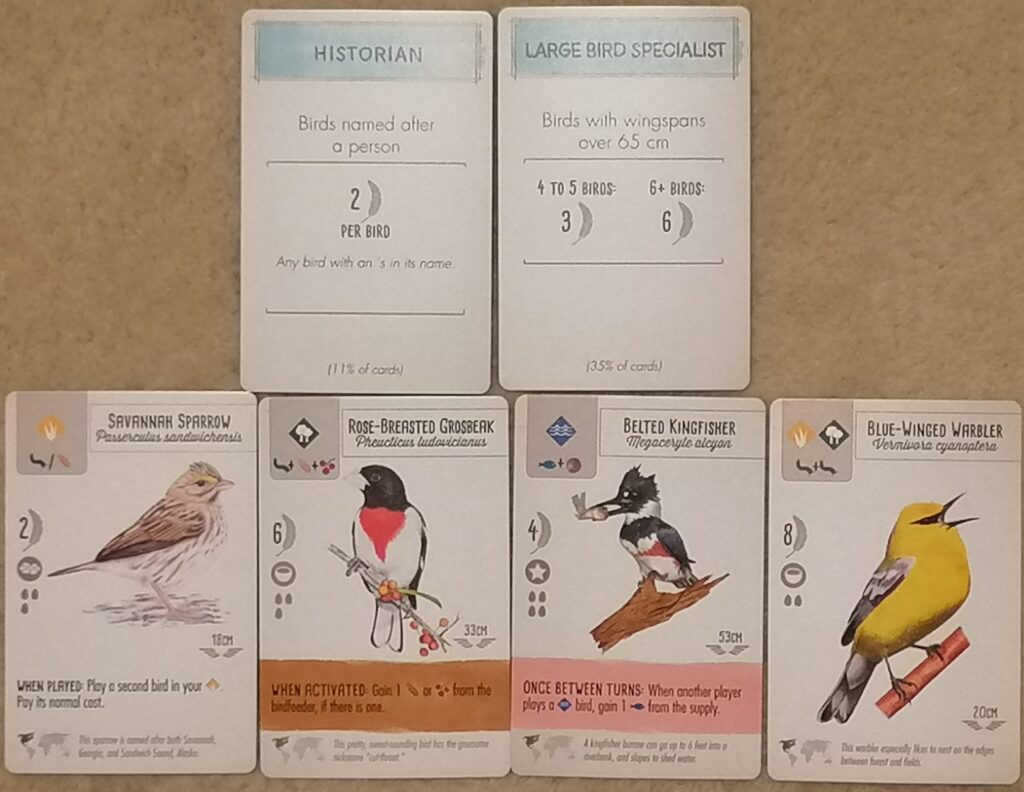
Why would you want a game where, as you go, you are able to do less and less? This is where the special powers I mentioned come in. Beneath the artwork on a card, the majority of cards will have either a brown power, a pink power or a power with no colour. The colourless powers are one-off abilities, such as allowing you to take more objective cards, but it’s the other two which are going to be most of use here. The pink powers allow you to gain things on an opponents turn, whenever they perform a specific action. The more pink cards you have on your board, the more potential you have for gaining resources which will help you throughout the game outside of your turn. The brown powers are essentially extra actions that you can activate on your turn, depending on the main action you take that turn.
Wingspan isn’t a standard engine-building game, as with these brown powers, you’re building a secondary engine within the main engine. When you take one of the actions tied in with the habitats, you place one of your action cubes in the right-most available space of that row. As an example, the forest action is all about gaining food, which you by taking the excellently made wooden dice. As more and more birds are played into the forest habitat, the number of dice you can take will increase. Now if you have birds in that habitat with brown powers, you not only get the main action of taking food, you also get to activate all the brown powers in that row, giving you potentially more things to do. It’s a fascinating aspect of the game. Not only am I thinking about strengthening certain actions, but I am also thinking about what type of powers I want to place where so that I can make the most of my turn.
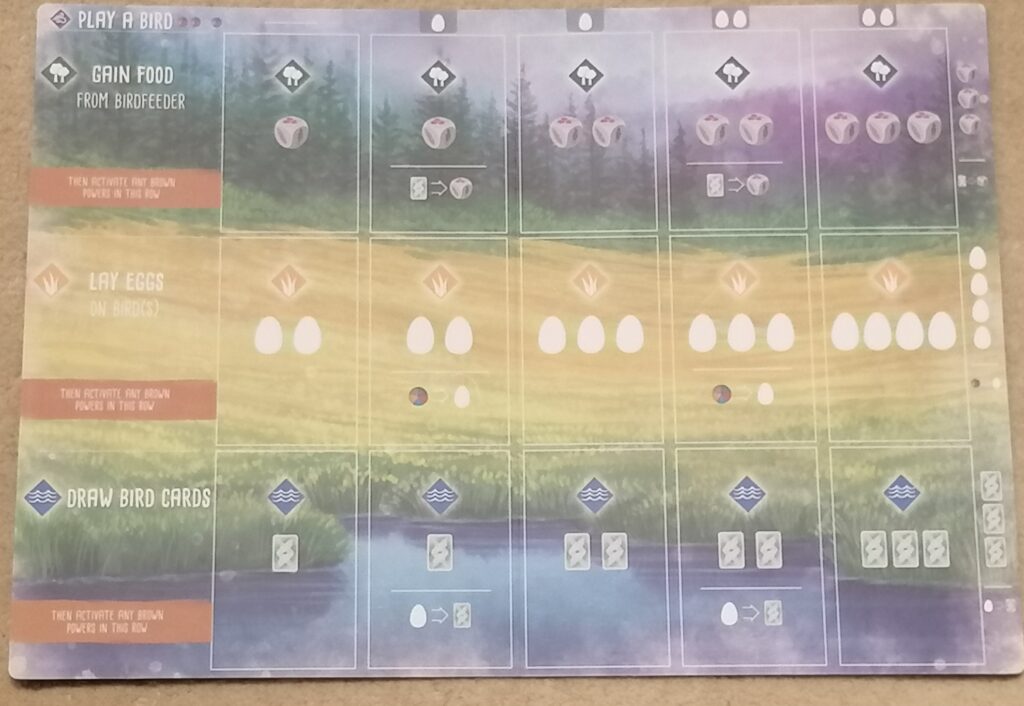
There are four main actions that you can take in this game, which again, is something that adds to that ease of play for potential newcomers, never overwhelming the player. Along with the forest habitat action, the two other habitat actions are ‘Lay Eggs’ and ‘Draw Bird Cards’. When drawing more bird cards, you can either take from the face up selection, or draw blindly from the deck, and the more birds you place in this row, the more cards you can take with each action. The grasslands action, laying eggs, is dependent on the birds you have already played. On the left-hand side of each bird card, you will see egg symbols, which represents how many eggs you can lay (place) on each bird. So you may take an action to lay four eggs, but if the birds on your board don’t have the initial capacity, or if you have maxed out their capacity, then you can’t lay them. Fortunately when you take this action you can split the eggs between as many birds as you want, which does help to do away with this issue somewhat. The fourth action also helps with the egg capacity issue. At the top of your board is the action to ‘Play a Bird’. You’ll place an action cube above the column you wish to play the bird. You will always start placement in the first column of their respective rows, and so you will only need to pay the food they require (this is show in the top left of the card, along with the habitat(s) into which the bird can be placed), but from the second column onwards, you will need to start paying eggs as well as food. This is something to watch out for; I have been caught out by forgetting that I will need to pay one or more eggs on top of food in the past.
People do have complaints about Wingspan, as with any game, some that seem more valid to me than others. Despite my views on the theme, some people do think that it is pasted on, and that you could remove it, replace it with a new one, and the game would still work just as well. Another complaint is that there’s not enough interaction between players in this game. The public objectives and pink powers are just a couple of reasons why I disagree with this. One thing I can understand however, though it is not a problem to me, is that some people think going for eggs over everything else is the best strategy. The grasslands action will give you at least two eggs each time you go for it, and each egg is worth one point at the end of the game, meaning that, as long as you can hold them, the eggs will always be more powerful than anything else. I have definitely seen it beaten on several occasions, through playing cards that are worth a lot of points, and cards that contribute to public or secret objectives, but the egg strategy it is a powerful option to fall back on.
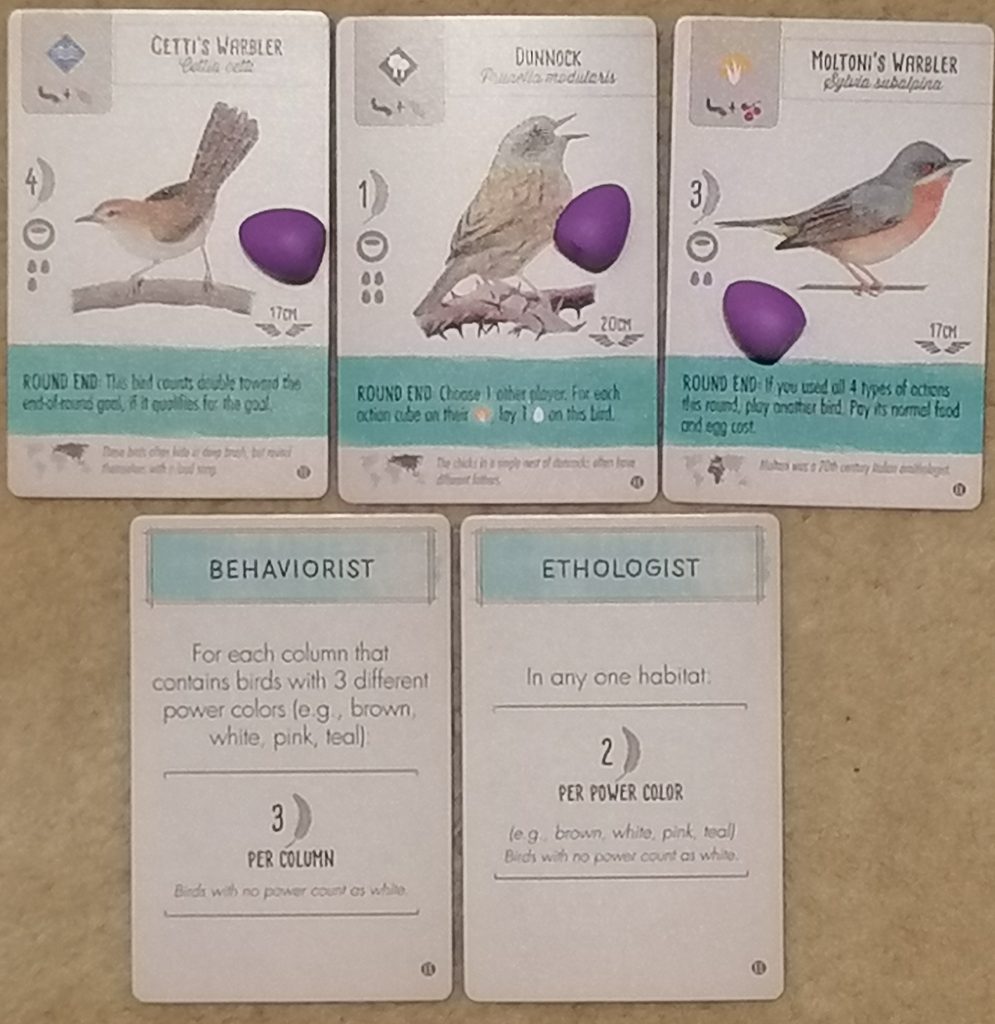
One way that this issue has been offset is through an expansion. Wingspan currently has two expansions: the European Expansion and the Oceania Expansion. The base game only highlights birds from North America, and, as you can assume, these two expansions highlight birds from their respective continents. The plan going forward is for an expansion to be done for each continent. I own the European Expansion, which along with new bird cards, adds new public and private objectives, and more eggs. Some of the new bird cards come with green powers. These are end-of-round abilities, potentially giving you even more actions to take even after everyone’s done, from allowing you to steal in to win an objective to just collecting more resources for the next round. The Oceania Expansion, along with more bird cards (some with yellow powers, which activate at the end of the game), new objectives and new eggs, comes with a new resource and new player boards. These boards mainly change how powerful the habitat actions are, and seem to deal with the issue of being able to rely on the egg strategy. It may be one I explore at some point, but for now, I am happy with the content I have.
This is a game that I would happily recommend to many different groups of people. If you’re a fan of engine-building games, definitely. If you’re a fan of clever card play, a fan of aesthetically pleasing games, or even if you’re just a fan of birds and looking to get into gaming, I think Wingspan is a wonderful game to explore, and the fact that this game has won award after award, along with the number of copies that have been sold, I’d say I’m not alone in thinking that.
| Prices delivered by BoardGamePrices | |
|---|---|
 | Wingspan £39.98 with shipping, in stock! Buy now See all 63 offers! |

